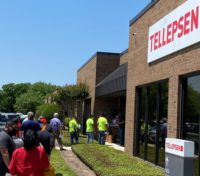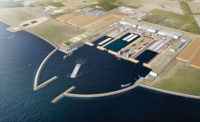Civil, defense and commercial launch vehicle providers have huge opportunities to create the infrastructure required for travel by humans further into space in the coming years, officials from the National Aeronautics and Space Administration, the U.S. Space Force and private companies such as Voyager Space said at the ASCEND conference at the Caesars Forum convention center in Las Vegas on Nov. 15.
ASCEND is an annual gathering sponsored by the American Institute of Aeronautics and Astronautics, a professional society of aerospace engineers.
"We need to think of what kind of infrastructure we need in space for civil needs, defense needs," said Deborah Tomek, senior advisor, On-orbit Servicing, Assembly and Manufacturing (OSAM) at NASA. The agency is talking with its defense partners about the need for an earth-to-space "superhighway" and how to create such infrastructure through OSAM, which is exploring a range of technologies including advanced robotics and additive manufacturing to allow everything from refueling or battery replacement of existing satellites to the construction of large telescopes in orbit.
There's also a defense angle to this discussion. On the same day that the conference was exploring this proposed delivery system, U.S. Space Command announced that a Russian test of a direct-ascent anti-satellite missile successfully struck one of the country's own satellites, but created a debris field in low-Earth orbit of more than 1,500 pieces of debris that caused concerns at the International Space Station.
“It’s necessary but certainly not sufficient to have physical, fixed assets," said Brigadier General John Olson, mobilization assistant to the Chief of Space Operations for the U.S. Space Force at the Pentagon. "I think we need both digital and physical assets, as space is so vast.”
For NASA and its long history of space exploration, embracing new ways to build fresh assets and service existing ones is largely cost-centered.
"We don’t have to gold-plate everything, we can go up repair, service, extend,” Tomek said. "A battery swap doesn’t sound exciting, but we have to figure out how to do logistics like that.”
Tomek said roughly 80% of the cost of everything NASA builds on the ground and sends into space is related to the launch vehicle and associated systems. The agency has also been limited by having to fit satellites, space-station sections and telescopes into the payloads of launch vehicles.
Tomek compared an OSAM project to create infrastructure in space to the construction of the Transcontinental Railroad and the Interstate System, and said that partnering with private providers could create the superhighway faster. "We don’t need to own this in government," she said.
Reaching Out to the Private Sector
For privately owned space exploration company Voyager Space of Denver, the potential of maintaining or servicing permanent space infrastructure is a business opportunity, and one that would require redefining what is conventionally considered infrastructure, said Adrian Mangiuca, vice president of infrastructure at Voyager Space.
Mangiuca added that since the existing insurance industry is unprepared to underwrite permanent space platforms or other OSAM-delivered infrastructure, private-sector entities will need government entities such as Space Force and NASA to partner with them.






Post a comment to this article
Report Abusive Comment